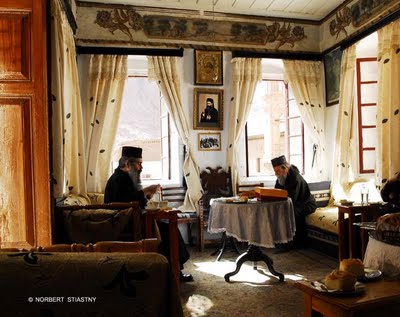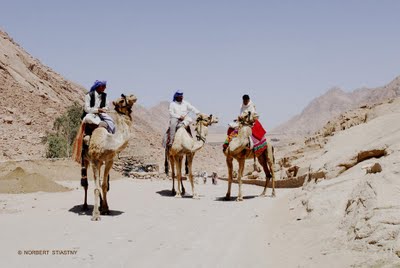My father-in-law is a photographer, and one of the great things about ‘have camera, will travel’ is that he occasionally gets to go on some fantastic trips. A while ago he was invited to visit the Eastern Orthodox St Catherine’s monastery in the Sinai Desert of Egypt by a friend who’s a scholar and restorer of old bookbindings (he works on incunabula, or books printed before 1501 – a lovely word, if a bit tricky to pronounce).
St Catherine’s – or ‘The Sacred and Imperial Monastery of the God-Trodden Mount of Sinai’, to give it its full Orthodox title – is a fascinating place and staggeringly old and precious. It was constructed in the 6th century making it the oldest working monastery in the world. It also houses one of the greatest collections of ancient documents in the world, second in size only to the Vatican. It’s a quite remarkable survivor: a priceless repository, a miraculously intact relic, but also a living institution.
It managed to attain its great age in such pristine condition as it’s never been sacked. This is down to its remoteness, its great defensive wall, and the political cunning of its monks. It’s probably also due to it sitting on ground that’s holy to all the religions of the book.
It’s reckoned to have the descendant of the original Burning Bush growing in its bounds. The Ten Commandments emanated from the neighbouring mountain, a revelation recognised by Muslims, as well as, of course, by Christians and Jews. A sign of this inclusivity is the presence of a mosque within the grounds of the monastery. (By the way, William Dalrymple’s From the Holy Mountain is an excellent if depressing source for further information on Eastern Christianity’s remaining sites).
The colony of monks has enjoyed plenty of patronage over the centuries. They were great favourites of the Tsar. But the most charming example of generosity is that of two English spinsters who, feeling the monks needed a bit of pampering, fitted out for them a little retreat-cum-library, the Sisters’ House. After masses on saint’s days and holy days the monks can gather here to indulge themselves with sweet coffee and honeyed cakes. They have also been known to take a nip of illicit brandy. One of those small pleasures that helps life roll along pleasantly enough, I’m sure.
Norbert’s photo of this ritual treat is at the head of the post (spot the sticky buns). I’ve also included below a shot of local mounted Bedouin, who provide most of the labour to support the monastic foundation. These are two examples taken from what is a stunning portfolio collected during his stay at the monastery. Some of the others can be viewed at various places on Norbert’s site (including a great shot of an ossuary too).
I think they’d make terrific, interestingly alternative Christmas cards: the bright light, crisp blue skies and stony landscapes are more reflective of the first Christmases than our snow and robins. If anyone is interested in pursuing this please feel free to contact Norbert via his site.













My first thought on seeing that top photo was how cozy it looked. There’s something so British about venturing to the remote places of the world and leaving a legacy of… sticky buns. It was once said of our decline that we were “sinking giggling into the sea”: well, it beats the heck out of a scorched earth policy. Did the sisters give them a drinks cabinet too? I do hope so.
…I think the ancient egyptians might have stolen a march on us with the sticky buns
These images look really interesting. I have visited the Sinai a number of times and kept meaning to make a trip to St.Catherine’s. My view of Orthodox priests though has been tainted by my experience of them in the Church of the Holy Sepulchre in Jerusalem where they are unfriendly, bad tempered hawkers of religious tat.
Many would blanch at the thought of visiting the holy land, after watching those scenes in Omen when David Warner had his head lopped off by a sheet of Pilkington’s finest and Leo McKern received a premature burial, all Damien’s fault.
Wonderfully medieval name Norbert and of course embedded within the memories of thousands of British motorists as the A6 version of Eddie Stobart..Norbert Dentressangle
Do we imagine that God actually trod the dusty paths of Sinai, his booming voice disturbing the silence and pausing only to smite yet another bunch of hoodies. I think of him as a sort of, well, float in the air kinda guy, Charlton Hestonesqe countenance beaming down upon the multitude, a whole bunch of angels and Yvette Cooper trailing along behind.
All of that changed of course when the tablets came hurling down, if only that wally Moses hadn’t stuck his nose in, I mean look where all of that malarkey ended up.
Very interesting post Gaw, you mention that the longevity of the monastery is “down to its remoteness, its great defensive wall, and the political cunning of its monks…and sitting on ground that’s holy to all the religions of the book”
can I add another factor to that? – The bone dry climate…I’d wager that a damp climate and rampant plant growth like ours here in Blighty is twice as damaging to buildings and books